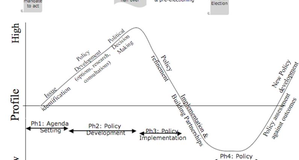Weight of Evidence Reporting: Pragmatic Optimism or a Bad Idea?
By
2015, Vol. 7 No. 10 | pg. 2/2 | « Some media viewers may confuse "experts" with "giant media personalities," who may not be experts themselves. In other words, these personalities will focus on the style expression—as opposed to the substance—of the message. Indeed, opinions and perceptions of climate change are especially apt to be influenced by trust – given the issue’s complexity, its politicization and connection to ideological values, its remoteness from everyday experience, and the public’s lack of knowledge about the topic (Bosch, 2014, p. 217; Hmielowski et. al, 2013, p. 871). In this sense, in the world of journalism, objectivity is strategic. Ironically, many journalists believe that objectivity—showing both sides of a story and explaining details without bias—is possible and believable (Hiles & Hinnant, 2014, p. 428). However, according to Dunwoody (2005), she would define objectivity as capturing truth claims accurately, even if you cannot find the truth (p. 90). Objectivity is related to balance, which calls for diverse viewpoints to be included in order for the reader to find truth in the claim somewhere in the news story (Dunwoody, 2005, p. 90; Hiles & Hinnant, 2014, p. 429). Weight of evidence sought to refine the notion of balance by inserting more scientific evidence into news stories (Hiles & Hinnant, 2014, p. 428). However, media consumers may not have the time nor the patience to sort through a large amount of information to find the truth. A typical media consumer relies on the media to help them find the objective truth—or at the very least—truth through the partisan lens to foster ideological agreement. Objectivity and balance are somewhat of an oxymoron in the media.While it is possible for a journalist to be quantifiably objective by paying attention to both sides of a given issue, by the end of each news story, a dominant argument must be revealed to the audience (Entman, 1993, p. 55). This dominant argument, of course, clouds the "full" objective spectrum of factions, opinions, and other arguments that can be made, but are unvoiced by the dominant argument. A journalist will also choose which aspects of the facts in certain partisan sides to analyze. Doing this will allow a journalistic piece to gain a partisan flavor, as it will advance their agenda or disparage the agenda of an opposing side. There will be facts that a journalist leaves out or even has to reorder to prime the media consumer's emotional reactions towards a specific subject. The effect is that many unassuming media consumers may confuse these selective opinions and arguments with fact. However, for more discerning media consumers, the role of validity will become apparent. Validity is closely related to objectivity and balance. Dunwoody (2005) defines validity as "… a measure of the goodness of fit between the source's message and the reporter's story. If the reporter has faithfully captured the meaning and intent of the source, she has done good work" (p. 90). Like objectivity, validity strives to capture truth claims accurately and, like balance, seeks to give experts with dominant or deviant opinions a chance to express their views. Of course, not all of the source interview information is used in a news story. The news story in question would be "framed" a certain way: it would have little pieces of the source interview sprinkled in to bolster the dominant ideological paradigm. However, validity may be looking more at social relationships (especially the ideological slant of the news source), as opposed to sound, objective arguments. In so doing, validity could simply be the measure of how you fit-in well with your ideological audience and not alienating them. RecommendationsConduct News DigitallyIn previous decades, one concern among media scholars was the lack of true, socially-transparent media that allowed the media to remain accountable to media consumers (McQuail, 2013, p. 11; Rowe & Frewer, 2000, p. 5). In previous decades, a media consumer could not voice their opinion on a whim to a media outlet, as "letters to the editor" or radio show call-ins required permission from the outlet to be voiced. Now, if any media consumer agrees or disagrees on a particular news piece's information, they can voice it in a myriad of different ways, such as comment boards, videos, and pictures, among others. No longer do digital media editors have to worry about the space constraints of newspapers or the time constraints of a 30-minute news segment (McCombs & Shaw, 1972, p. 184). More importantly, however, sources can be cross-referenced by including embedded links to scientific papers. Since media consumers need shortcuts, the inclusion of these scientific reports will save them a significant amount of time that would have spent researching the issue closer—an arduous task that not every media consumer would be willing to do. These elements make media more of a two-way conversation, as opposed to the one-way communication inherent in many academic articles. Likewise, unlike newspapers that need to be shipped globally, digital media is accessible anywhere there is a connection to the internet. With today's portable media devices that connect via a wireless phone signal, news media can be accessed and produced from virtually anywhere. Likewise, data can be accessible real-time to identify key trends. With this global reach, the two-way communication dialogue will be much more diverse, as opinions from diverse cultures and countries will foster new ways of interpreting a scientific issue. When an issue like global change is examined globally, scientists will gain a deeper sense of how the issue can affect other countries. Scientists Should Speak to a Lay AudienceScientists should understand how to market themselves, as they have been much slower than partisan media at adapting to communications technology that speaks to a larger audience (Scheufele, 2014, p. 13587). Social media helps a scientist to market the work that they do. Keep in mind that such a social media account would not have to be created solely for the scientist alone; it could be institutionally affiliated with where they perform their research. After all, many institutions (academic or otherwise) have social media accounts that highlights the groundbreaking research of their scientists. When a scientist uses social media, they don't have to "dumb down" their work, but turn their findings into a more friendly conversation to promote a larger debate. Scientists can start to generally talk about climate change, as well as the other laws that are in effect that do effect the daily lives of their audience segments—even if they are not readily aware of it (Scheufele, 2014, p. 13588). Since global warming is an often-misunderstood topic among audience segments, scientists should correct or clarify information. Highly technical, scientific terms should be "translated" into everyday language and do not necessarily have to be politically-charged. Rather, scientists need to define the ramifications of global warming, as well as what can be done. However, a question emerges: how can science communication adapt to the partisan media landscape? Simply put, scientists should state their views and reveal the scientific evidence supporting those views. Much of the analysis for the scientific ramifications will be done by the particular partisan media outlet anyways. However, scientists can remain balanced amidst a highly partisan and subjective media landscape by citing irrefutable quantifiable evidence. After all, it is one thing to cite a fact and give a slanted argument for or against it; it is another thing to give irrefutable scientific evidence. Scientists and Partisan News Should be Held Accountable to their AudienceWhen a scientist appears on the media presenting their evidence for or against global warming, they are effectively putting their reputations on the line (Scheufele, 2014, pp. 13585-13586). While the appearance would undoubtedly look good on their CV, there is the responsibility—much like when they appear at an academic conference—to field questions about their work. This may explain why media is so partisan in an issue such as global warming, as the experts that were acquired by a specific partisan news outlet aren't accountable to the audience directly. This third recommendation ties closely to the first two recommendations. Regarding the first recommendation, with digital media, there will often be a comment board that users can interact with the scientists who performed the research. Scientists, as well as the media, should be prepared to field questions that could include audiovisual elements like pictures and video. Like a "citizen journalist," media consumers can identify key pieces of evidence regarding global warming and send the results to either the scientists or the media. ConclusionThe tug of war between objective science and subjective media has been a source of friction for many years. While the goal of creating more pragmatic, scientifically-literate media consumers is admirable, weight of evidence reporting is too optimistic in theory in the world of partisan media. Although scientific data alone can tell much about global warming, time-pressed media consumers often will not find out about scientific evidence unless they either research the issue heavily or expose themselves to partisan media. Since scientists may not know how to market their data directly to consumers, they will often rely on the subjective partisan media to communicate their views. Objectivity in partisan media is somewhat of an oxymoron because, while a news story can be quantifiably objective in the amount of time it pays attention to both sides of an issue, an ideologically-dominant paradigm that is sympathetic with their views will ultimate emerge. ReferencesBosch, B. (2014). Beyond vox pop: The role of news sourcing and political beliefs in exemplification effects. Mass Communication & Society, 17, 217-235. Denham, B. E. (2014). Intermedia attribute agenda setting in the New York Times: The case of animal abuse in U.S. horse racing. Journalism & Mass Communication Quarterly, 91, 17-37. Dunwoody, S. (2005). Weight-of-evidence reporting; What is it? Why use it? Nieman Reports, 59(4), 89-91. Entman, R. M. (1993). Framing: Toward clarification of a fractured paradigm. Journal of Communication, 43, 51-58. Hampton, K.N., Goulet, L.S., Rainie, L., & Purcell, K. (2011). Social networking sites and our lives: How people’s trust, personal relationships, and civic and political involvement are connected to their use of social networking sites and other technologies. Retrieved from http://www.pewinternet.org/2011/06/16/social-networking-sites-and-our-lives/ Hiles, S.S. & Hinnant, A. (2014). Climate change in the newsroom: Journalists' evolving standards of objectivity when covering global warming. Science Communication, 36(4), 428-453. Hmielowski, J. D., Feldman, L., Myers, T. A., Leiserowitz, A., & Maibach, E. (2013). An attack on science? Media use, trust in scientists, and perceptions of global warming.Public Understanding of Science, 23(7) 866-883. Horwitz, R.P (2014). Americans’ problem with global warming. Retrieved from http://myweb.uiowa.edu/rhorwitz/globalwarming.htm Iyengar, S., & Kinder, D. R. (1987). The priming effects. In S. Iyengar and D. R. Kinder, News that matters (pp. 63-72). Chicago: University of Chicago Press. Jones, J.M. (2010). Conservatives’ doubts about global warming grow. Retrieved from http://www.gallup.com/poll/126563/conservatives-doubts-global-warming-grow.aspx Kahan, Jenkins-Smith, & Braman, D.M., Jenkins-Smith, H., & Braman, D. (2011). Cultural cognition and scientific consensus. Journal of Risk Research, 14(2), 147-174. Katz, E., Blumler, J. G., & Gurevitch, M. (1973). Uses and gratifications research. Public Opinion Quarterly, 37, 509-523. Lewandowsky, St, Gignac, G.E., & Vaughan, S. (2012). The pivotal role of perceived scientific consensus in acceptance of science. Nature Climate Change, 3, 399-404. McCombs, M. E., & Shaw, D. L. (1972). The agenda setting function of the mass media. Public Opinion Quarterly, 36, 176-187. McLeod, J. M. & Reeves, B. (1981). On the nature of mass media effects. Mass Communication Review Yearbook, 2, 245-282. McQuail, D. (2013). The media audience: A brief biography-Stages of growth or paradigm change? The Communication Review, 16, 9-20. NOAA National Climatic Data Center. (2013). Global analysis – 2013. Retrieved from https://www.ncdc.noaa.gov/sotc/global/2013/13 NOAA National Climatic Data Center. (2014). Global analysis – 2014. Retrieved from http://www.ncdc.noaa.gov/sotc/global/2014/13/supplemental/page-4 Petty, R., & Cacioppo, J. (1984). The effects of involvement on response to argument quantity and quality: Central and peripheral routes to persuasion. Journal of Personality and Social Psychology, 46, 69-81. Potter, W. J. (2009). Conceptualizing the audience. In R. L. Nabi & M. B. Oliver (Eds.), The SAGE handbook of media processes and effects (pp. 19-34). Thousand Oaks, CA: SAGE. Rowe, G. & Frewer, L.J. (2000). Public participation methods: A framework for evaluation. Science Technology Human Values, 25(1), 3-29. Scheufele, D.A. (2014). Science communication as political communication. PNAS, 111(4), 13585-13592. Stocking, S.H., & Holstein, L.W. (2009). Manufacturing doubt: Journalists’ roles and the construction of ignorance in a scientific controversy. Public Understanding of Science, 18, 23-42. Zillmann, D. (1988). Mood management through communication choices. The American Behavioral Scientist, 31, 327-340. Zillmann, D. (1999). Exemplification theory: Judging the whole by some of its part. Media Psychology, 1, 69-94. Suggested Reading from Inquiries Journal
Inquiries Journal provides undergraduate and graduate students around the world a platform for the wide dissemination of academic work over a range of core disciplines. Representing the work of students from hundreds of institutions around the globe, Inquiries Journal's large database of academic articles is completely free. Learn more | Blog | Submit Latest in Business & Communications |


















